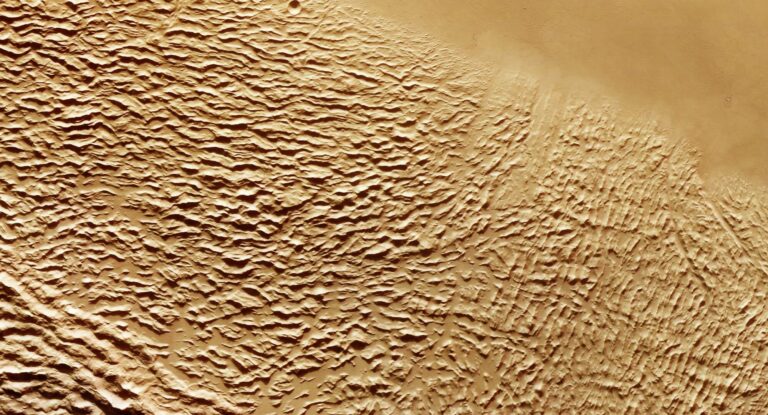Differences in Planetary Size and Corresponding Cooling Rates Could Account for Mars’ Demise and Earth’s Survival
The red planet, Mars, is widely known for its surface and atmosphere covered in swirling dust of rusted iron, giving it its distinct appearance. However, this was not always the case.
Robotic missions sent to Mars over the past fifty years have provided evidence that the planet was once a vibrant and possibly even green world. The presence of water is evident everywhere we look, from ancient flood plains to seabeds and alluvial fans. If I were to show you two pictures, one from Mars and one from a desert on Earth, you would not be able to tell the difference.Although Mars may not have had as much liquid water as Earth, we are confident that it once had vast oceans, meandering rivers, and a climate featuring rainy and overcast days.
While we are still uncertain if the right chemical combinations occurred on Mars to support life, we do know that billions of years ago, during the early days of our solar system, there were two Earth-like planets orbiting within the habitable zone of our star.However, Mars was cursed with a flaw that prevented the development of life on its surface. Despite its fiery appearance in our night sky, Mars is relatively small, with a mass only about 11% that of Earth. This small mass caused its core to cool down much faster than it should have.
All planets possess warmth, deriving from both the decay of radioactive elements and the residual heat from their formation. The process of collapsing a vast, diffuse gas and dust cloud into a compact volume generates friction, which in turn produces heat.
This heat remains trapped within the planet as it takes shape. The sole means of its escape is through the emission of radiation into the vacuum of space. However, radiation is an extremely inefficient method of heat transfer. To illustrate this, consider the chilling fact that if one were to be cast into the vacuum of space, far from the sun, it would take several hours to freeze.
As planets emit infrared radiation, they gradually release the internal heat and cool down.
Earth, being larger than Mars, possesses an abundance of residual heat for two reasons. Firstly, its larger size allowed it to accumulate more heat during its formation. Secondly, while the heat is contained within the planet’s volume, it can only radiate from its surface. When the size of a planet doubles, its surface area quadruples, but its volume increases eightfold. Consequently, larger planets release heat at a slower rate compared to smaller ones. In essence, we are significantly less efficient than Mars in dissipating our heat.
The intense heat within our planet’s core maintains its molten state. Deep beneath the surface, thousands of miles down, charged elements such as iron engage in a complex dance, creating a powerful magnetic field. This magnetic field acts as a shield, deflecting the constant bombardment of charged particles from the sun, known as the solar wind, and safeguarding our atmosphere. Without this crucial magnetic field, our air would dissipate like dandelion seeds carried away by the wind.
Unfortunately, Mars suffered from a flaw. Being relatively small, its core cooled and solidified within a billion years, resulting in a weakened magnetic field. Deprived of this protection, Mars lost its atmosphere. The absence of atmospheric pressure caused the water on its surface to boil and evaporate into gas, which was then swept away by the solar wind, eventually escaping the confines of our solar system. Now, that water has become part of the vast expanse of interstellar space, forever beyond our reach.
With this tragic loss, Mars met its demise, extinguishing any possibility of life on that desolate world.
This article is republished from PhysORG under a Creative Commons license. Read the original article.
Do not forget to share your opinion with us to provide you with the best posts !




0 Comments